CHRISTIANITY
About 2.5% of Indiaís
population are Christians. Christianity arrived in India almost about the same
period as it arrived in Europe, meaning about 2000 years ago. Christianity
originates in Israel. The first Christians were Jews and in the beginning
Christianity was seen as a Jewish cult. Most of the Apostles of Christians acted
in Europe to convert the Europeans to Christianity. But one of the Apostles, St.
Judas Thomas, arrived in India and converted Indians to Christianity. St. Thomas
was a carpenter and a disciple of Jesus. He was brought to India by a merchant
to build a temple. St. Thomas arrived in Kerala, in south India in 52 AD. He
succeeded in converting local Indians to Christianity. His converts were called
Syrian Christians. Later on other Christian saints arrived to India as
missioners. But most of the Indian were converted to Christianity by the
missionaries who arrived in India with the European powers from 15th century.
The European powers
arrived in India for commercial reasons, especially spices. But they also
started converting local Indians to Christianity. Five European countries sent
their representatives to India, Great Britain; France; Denmark; Netherlands and
Portugal. Of the five European powers the Portuguese were most enthusiast to
baptize Indians. The Portuguese were the first European power to arrive in
India. Their first ship, under the leadership of Vasco DaGama, arrived in south
India in 1498 after it had circled the whole continent of Africa. The Portuguese
inspired by the Popeís order to baptize people around the world not only fought
wars against the local Indian rulers, but they even tried to enforced their
Roman Catholic prayers on Syrian Christians.
After many wars the
Portuguese were defeated by local rulers and they had only one big pocket of
control in India, Goa. The Portuguese not only fought the Indian rulers, but
they also fought against other European powers in India especially Dutch and
English. Many Portuguese churches in Kerala were turned into English and Dutch
churches after they were captured by these powers.
The English
missionaries started acting in India at a much later period. The British, unlike
the Portuguese, didnít allow the missionaries to enter their territory in the
beginning. The British arrived in India in 1600 and they allowed the
missionaries to enter their territory only from 1813. The British allowed
different churches to establish missionaries in their territory. The
missionaries didnít only spread Christianity, but they also did humanitarian
deeds giving the needy basic necessities of life like food, clothes and shelter.
The missionaries also built schools in India and many of them even today have
Christian or European originated name. The British church missionaries succeeded
less than the Portuguese in converting Indians to Christianity, but unlike the
Portuguese who tried to enforce Christianity, these Protestant converts were
voluntary. The Portuguese were also aware of the Indian custom according to
which the wife followed her husbandís faith and therefore married their men to
Indian women.
There are about 30
million Christians in India. The major centers of Christianity in India are
Kerala, Tamil Nadu, Goa, Manipur and Mizoram. There is also a big community of
Christians in Mumbai. The main division of Christians in India is like in the
Christian world, Protestants and Catholic. There are also different denomination
among them, Syrian Church, Armenian Church, Anglican Church and others. Most of
the India Christians were converted by the Portuguese. There is also an
Anglo-Indian community in India.
Churches
in India
Churches in India have got a lot
of influence from the western world, thanks to the colonial rulers. Portuguese
came to India and brought with them the Latin cultural heritage, which one can
very well witness in Goa. But the churches of Old Goa are something one won't
be able to forget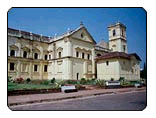 ever.
Enriched with intricate designs and beautiful interiors these churches tell
you the stories of the Portuguese glory and endless devotion.
ever.
Enriched with intricate designs and beautiful interiors these churches tell
you the stories of the Portuguese glory and endless devotion.
In Pondicherry, French made an impact that can be seen even today. Kerala has
Dutch architecture very much in common in their churches. Not leaving the
British behind Christ Church and St. Michael's Church in Himachal Pradesh is
the one of the biggest attraction of the capital, Shimla.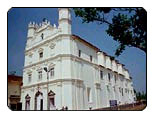
Churches in Goa
The most comprehensive group of churches and
cathedrals built during 16th to 17th century AD at Old Goa comprise of the Se'
Cathedral, Church and Convent of St. Francis of Assisi, Chapel of St.
Catherine, Basilica of Bom Jesus; Church of Lady of Rosary; Church of St.
Augustine.
The Church of St. Cajetan is modeled on the original design of St. Peter's
Church in Rome. The Church of Bom Jesus with its facade decorated with Ionic,
Doric and Corinthian pilasters, shows the application of the Classical order.
The Se' Cathedral, with its Tuscan exterior, the Corinthian columns at its
portals, the raised platform with steps leading to the entrance, the
barrel-vault above the nave, is yet another example of Renaissance.
The paintings in the churches were done on wooden borders and fixed between
panels having floral designs as in the chapels housing the tomb of St. Xavier,
the arches above the altars in the transept of the Se' Cathedral and in the
nave on either side of the main altar in the Church of St. Francis of Assisi.
Excepting a few which are in stone, the statues are mostly in wood delicately
carved and painted to adorn the altars. They depict mostly the saints, Mother
Mary and Jesus on the cross.
|
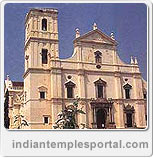
St. Cathedral Church
- Goa
|
 |
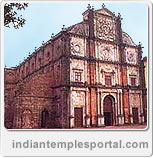
St. Francis Xavier
Church - Goa
|
|
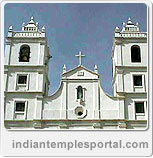
|
 |
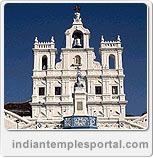
St. Christ Church -
Shimla
|
|
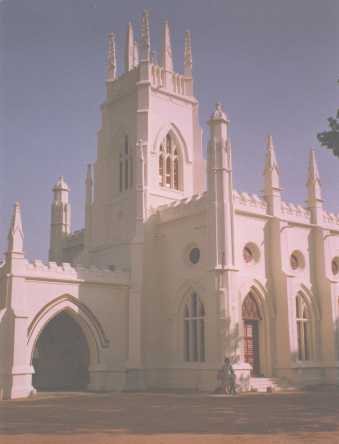
|
|
St Matthias' Church,
Vepery, Madras |
Some of the
other famous Churches in India
Christ Church & St.
Michael's Cathedral, H.P.
The most prominent building on the famous Mall of Shimla is the yellow Christ
Church, reputed to be the second oldest church in northern India. It still has
those lovely stained glass windows for which it is so famed.
Se Cathedral, Goa
Se Cathedral is the largest church among the group of churches in Old Goa. It
took eighty years to build this church, but it was not consecrated until 1640.
Church of St Francis of
Assisi, Goa
This church is the former palace of the Archbishop that connects the Se
Cathedral to the Convent and Church of St. Francis of Assisi. The exterior of
the Church is of the Tuscan order while the main entrance is in Manuline
style.
Santa Cruz Basilica, Kerala
The Santa Cruz Basilica is a historic church that was built by the Portuguese.
The church was elevated to a cathedral by Pope Paul IV in 1558 AD. In 1795 AD,
it fell into the hands of the British when they took over Cochin and was
demolished.
Medak Church, Medak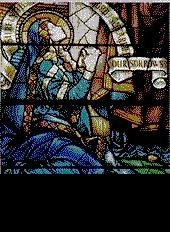
The church has an impressive style of
vaulting and large windows on either sides of the hall and the windows at the
entrance are provided with pieces of coloured glass fitted in metal frames.
The coloured glass pieces are beautifully arranged to depict scenes from the
bible and Crucifixion of Jesus Christ. They serve as a picture book of the
Bible to those who cannot read. The colour spectrum produced by these windows
inside, by the early and late afternoon sun is marvelous.
With its immensity and beauty, this century
old church which was completed in 1924 stands out as one of the finest
examples of Gothic architecture in India.
Churches
listed - state wise
Churches of
Andhra Pradesh
(Outside
Hyderabad)
- Medak Church
- Gundala Church
Churches of Delhi
- Church of the Sacred Heart
- Cathedral Church of the Redemption
Churches of Goa
- Ruins Of St. Augustine's Tower
- Se Cathedral
- The Chapel Of Our Lady Of The Mount
- The Chapel Of St. Catherine
- The Church And Convent Of St. Monica
- The Church Of Our Lady Of The Rosary
- The Church Of St. Cajetan
- The Church Of St. Francis Of Assisi
- The Church Of St. Francis Xavier
- The Church Of The Carmelites
- The Convent And Church Of St John Of God
- The Convent And The Church Of The Cross Of Miracles
- The Professed House & The Basilica Of Bom Jesus
- The Royal Chapel Of St. Anthony
Churches of Himachal pradesh
- Christ Church and St Michael's Cathedral
- The Catholic Church of St. Francis
- St. John's Church-In-Wilderness
- The Christ Church
Churches of Karnataka
churches of Kerala
- Malayatoor Church Valiya Palli Church
- Santa Cruz Basicillica
- St. Francis Church
Churches of Maharashtra
- Afghan Memorial Church
- Holy Christ Church
- Mount Mary Church
Churches of Uttar Pradesh
- All Saints Cathedral
- Christ Church Holy Trinity
- Jamuna Church
- Kanpur Memorial Church
- St. George's Church
- St. John's Church
- St. Joseph's Church
- St. Joseph's Roman Catholic
- St. Mary's Church
 ever.
Enriched with intricate designs and beautiful interiors these churches tell
you the stories of the Portuguese glory and endless devotion.
ever.
Enriched with intricate designs and beautiful interiors these churches tell
you the stories of the Portuguese glory and endless devotion.





